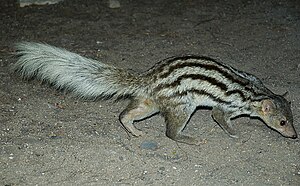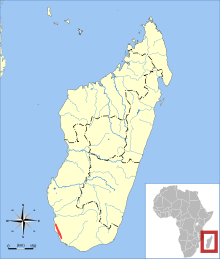Large broad-striped mongoose
| Large broad-striped mongoose | ||||||||||||
|---|---|---|---|---|---|---|---|---|---|---|---|---|

Greater broad-striped mongoose ( Galidictis grandidieri ) |
||||||||||||
| Systematics | ||||||||||||
|
||||||||||||
| Scientific name | ||||||||||||
| Galidictis grandidieri | ||||||||||||
| Wozencraft , 1986 |
The large broad-striped mongoose ( Galidictis grandidieri ) is a species of predator from the group of Malagasy predators (Eupleridae).
features
Large broad-striped mongooses are similar to their relatives, the broad-striped mongooses , but are significantly larger. They reach a head body length of 45 to 48 centimeters, a tail length of 30 to 33 centimeters and a weight of 1 to 1.7 kilograms. This makes them the largest representatives of the Madagascar mongooses . Like all representatives of this group, they have an elongated body with short limbs. Eight dark brown vertical stripes run along the back, with slightly wider, light gray stripes in between. The belly is dark brown in color, the elongated snout and the feet are reddish brown. The bushy tail, which is shorter than the trunk, is whitish.
Distribution and way of life
Large galidictis are on Madagascar endemic, their habitat is the dry, with Didiereaceae passed thorn forests in the southwest of the island.
They are nocturnal and mostly stay on the ground, but sometimes climb trees. During the day they sleep in caves or crevices, at night they go in search of food. Often there are observations of solitary animals or those living in pairs, rarely groups of up to five animals. As far as is known, the diet of these animals consists mainly of invertebrates, primarily Madagascar hissing cockroaches , but also grasshoppers and scorpions , and rarely also of vertebrates.
Mating can probably take place all year round, the litter size is one or two young.
Danger
The large broad-striped mongoose was only described as a separate species in 1986 on the basis of museum specimens; live animals have only been known since 1989. The entire range covers less than 500 km², the total population is estimated according to various estimates at between 2200 and 3540 individuals. The IUCN lists the species as "critically endangered" ( endangered ).
literature
- Don E. Wilson, Russell A. Mittermeier (Eds.): Handbook of the Mammals of the World. Volume 1: Carnivores. Lynx Edicions, 2009, ISBN 978-84-96553-49-1 .
- Nick Garbutt: Mammals of Madagascar. A Complete Guide. Yale University Press, New Haven & London 2007, ISBN 978-0-300-12550-4
Web links
- Galidictis grandidieri onthe IUCN Red List of Threatened Species . Retrieved on June 17, 2009.
